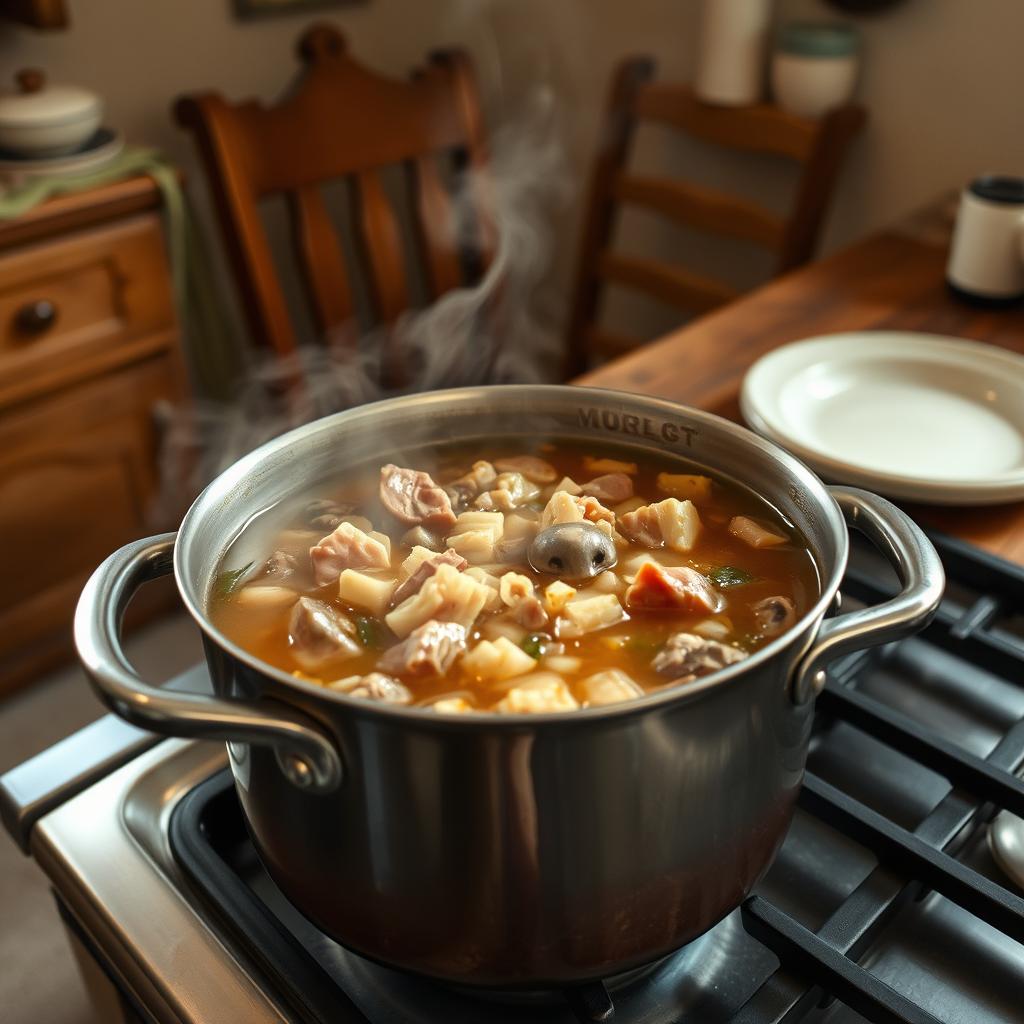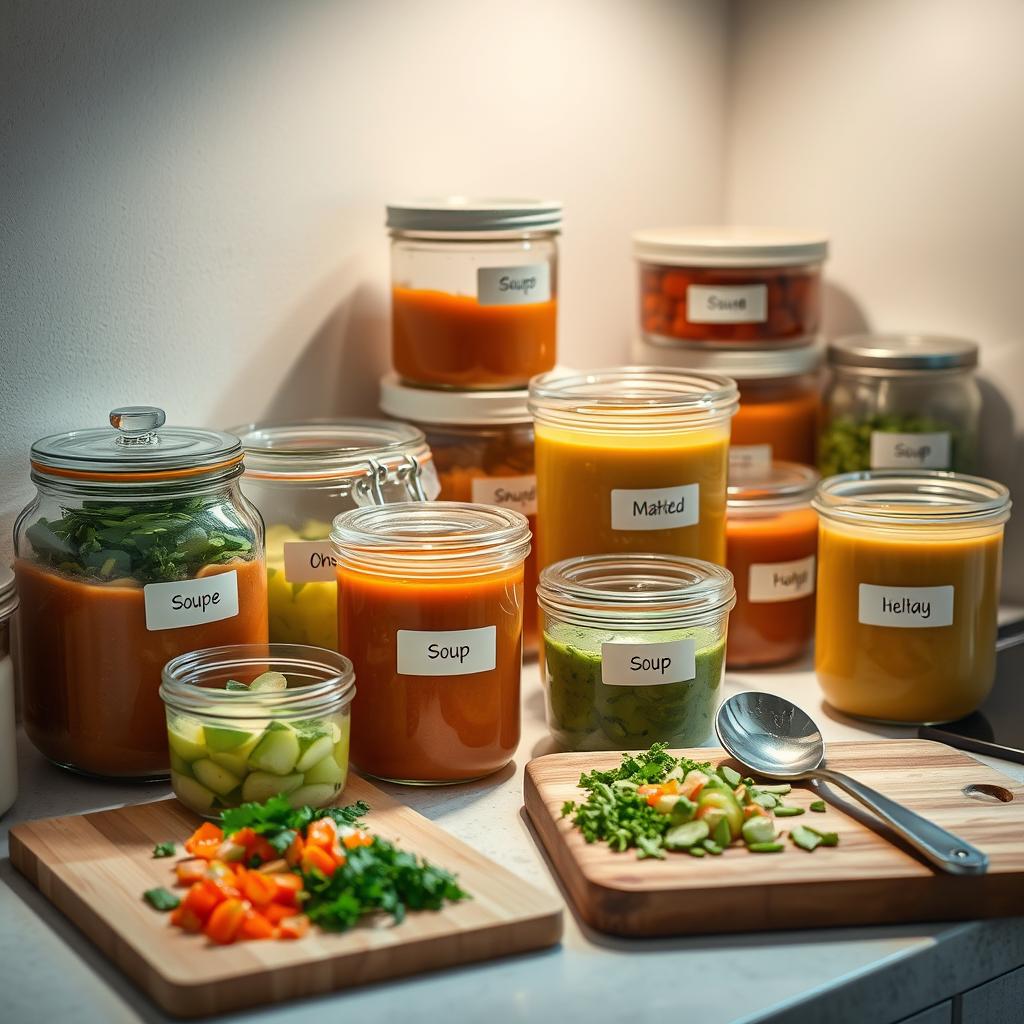When it gets cold outside, nothing is better than a warm bowl of ham and mushroom sauerkraut soup. This hearty winter soup mixes the salty taste of ham, the earthy flavor of mushrooms, and the tangy crunch of sauerkraut. It’s a comforting and satisfying meal that warms the soul.
This sauerkrat soup recipe is a classic dish that honors traditions from generations past. It’s a meal that brings people together, especially during the cold months.

This soup has its roots in European cooking but is loved all over the country. It’s a hearty meal that’s perfect for any chilly day. The slow-cooked ingredients create a rich and balanced flavor that’s both rustic and refined.
Whether you’re making it for a quick dinner or a big family meal, it’s like getting a big hug in a bowl. It’s a dish that brings warmth and comfort to any table.
Key Takeaways
- Combines sauerkraut, ham, and mushrooms for a bold flavor mix.
- Simple ingredients create a hearty winter soup ideal for cold-weather comfort.
- Follow the sauerkrat soup recipe for a dish ready in under an hour.
- Perfect for leftovers—tastes even better the next day!
- Customizable with spices like caraway or paprika to match your taste.
Introduction to Ham and Mushroom Sauerkraut Soup
Ham and Mushroom Sauerkraut Soup is a cozy mix of tradition and taste. It brings old-world flavors into modern kitchens. This soup has its roots in kitchens where fermented cabbage soup was a staple, now loved as a comfort food.
It’s perfect for cold days. This dish combines heritage with hearty ingredients. It warms both body and soul.
The Rich History of Sauerkraut Soups
Eastern European cuisines made this soup a winter must-have. From Poland to Russia, Eastern European soup recipes used fermented cabbage. This preserved food and fueled workers.
Over time, it moved from peasant tables to festive gatherings. The tangy fermented cabbage soup base became a symbol of resilience and flavor.
Why This Soup Is Perfect for Cold Weather
Winter needs hearty meals, and this soup is it. The rich broth and hearty ingredients make it a top cold weather recipes pick. Every spoonful brings warmth.
Smoky ham and earthy mushrooms balance the sauerkraut’s sharpness. It’s more than a meal—it’s a hug in a bowl.
What Makes This Recipe Special
This version stands out with a balanced flavor. Smoked ham adds depth to the fermented cabbage soup base. Mushrooms add texture contrasts.
The secret? A harmony of tang, salt, and earth. It avoids overpowering any single note. This dish honors tradition while inviting innovation. It shows classic Eastern European soup can still surprise.
Essential Ingredients You’ll Need
Making a tasty homemade ham soup begins with the right ingredients. Let’s look at what you’ll need for this hearty dish:
- Ham: 1.5 lbs of smoked or unsmoked ham (see section 4 for type comparisons)
- Mushrooms: A mix of cremini and button mushrooms add earthy depth
- Fermented cabbage: 2 cups of sauerkraut (store-bought or homemade)
- Aromatics: 1 large onion, 3 garlic cloves, 2 carrots
- Broth: 6 cups chicken or vegetable broth (low-sodium recommended)
- Herbs: Bay leaf, fresh thyme, and dill for aromatic layers
“The secret to great soup lies in balancing acidity and umami,” says Chef Maria Lopez of traditional German cuisine. “Fermented cabbage brings tanginess that elevates every bite.”
For soup ingredients substitutions: Use leftover holiday ham to cut costs. Swap mushrooms with rehydrated porcini for intensity. Always rinse store-bought sauerkraut if reducing salt content. Fresh herbs add brightness, but dried alternatives work in a pinch.
Quality matters most with fermented cabbage—opt for unpasteurized jars for live probiotics. This homemade ham soup shines when ingredients are fresh but flexible. Adjust quantities to taste, but stick to the core components for authenticity.
The Perfect Ham for Your Soup
Choosing the right ham makes this soup even better. We’ll look at options that fit your taste and what you have at home.
Smoked vs Unsmoked Options
Smoked ham brings deep, savory flavors. Go for Smithfield or Black Forest hocks or shanks for a rich broth. If you prefer a tangy taste, unsmoked ham is the way to go. Boneless cuts ensure even cooking.
Repurpose Leftovers
Make the most of leftover ham recipes in this soup! Crumble holiday ham, like honey-glazed, and watch out for saltiness. Cube leftover ham for texture. Remember, broth can help balance sweetness.
Meat Swaps for All Palates
Being flexible is important. Here are some soup meat options:
| Option | Best For | How to Use |
|---|---|---|
| Smoked Turkey Breast | Lighter meals | Cubed and simmered last to avoid overcooking |
| Beef Brisket | Heartier flavors | Slow-cook with vegetables before adding broth |
| Tofu or Seitan | Plant-based diets | Crisp tofu in a pan first for better texture |
Selecting and Preparing Mushrooms
Choosing the right mushrooms makes your mushroom soup better. You can use fresh or dried mushrooms. Each adds a unique flavor to your sauerkraut soup.
Best Mushroom Varieties for This Soup
Button mushrooms give a light taste. Cremini mushrooms add earthiness. Wild mushrooms like porcini or hen-of-the-woods bring a strong umami flavor. Shiitake mushrooms have a meaty texture that’s great in soups.
For a mix of flavors, try combining two types of mushrooms. This creates a balanced taste experience.
Cleaning and Slicing Techniques
Be gentle when handling mushrooms. Do not soak them. Instead, use a damp towel or soft brush to clean them. Trim the stems of thick mushrooms like portobello.
Slice mushrooms evenly for even cooking. Here’s how to slice them:
- Quarter small mushrooms (button/cremini)
- Slice thick caps into ¼-inch strips
- Reserve any flavorful stems for broth
Dried Mushroom Alternatives
Use ¼ cup dried mushrooms as a substitute for 1 cup fresh. Soak them in warm water for 20-30 minutes. Then, chop and add them to your soup.
Strain the soaking liquid but don’t throw it away. Use it to replace half of the broth. This dried mushroom preparation method boosts umami without losing texture.
All About Sauerkraut in Cooking
Sauerkraut isn’t just for hot dogs—it’s a tangy soup base with centuries of tradition. It’s made from fermented cabbage. Its sharp flavor adds depth to soups and offers probiotics for gut health. Here’s how to choose and use it best:
- Jarred: Mild and convenient, great for beginners.
- Bagged: Stronger taste, perfect for bold soups.
- Refrigerated: Fresher than jarred, with live cultures.
- Homemade: Fully customizable, ideal for flavor control.
| Type | Flavor Intensity | Probiotics | Best Use |
|---|---|---|---|
| Jarred | Mild | Low (pasteurized) | Quick meals |
| Refrigerated | Medium | High (unpasteurized) | Health-focused cooking |
Rinse sauerkraut if you prefer less tanginess, but leave the brine for full flavor. When cooking, heat destroys most live probiotics, but the unique taste remains. Add 1–2 cups to soups based on your preference—start small and adjust. For skeptics, pair it with savory ingredients like ham and mushrooms to balance the tang.
Step-by-Step Cooking Instructions

Mastering this dish starts with careful execution at every stage. Follow these steps to unlock bold, balanced flavors:
Preparing Your Base
Sauté diced onions, garlic, and carrots in a Dutch oven until translucent. Add cubed ham to render its fat, creating a savory base. This step uses classic soup cooking techniques to layer foundational tastes without overwhelming the pot.
Adding Ingredients in the Right Order
Introduce broth first to hydrate sauerkraut, then add mushrooms. Wait until the last 20 minutes to incorporate leafy herbs like thyme—this sequence ensures proper flavor development without overcooking delicate ingredients.
Simmering for Maximum Flavor
Bring to a boil, then reduce to a gentle slow simmered soup setting. Simmer uncovered for 45 minutes, stirring occasionally. The low heat breaks down fibers in mushrooms and ham, releasing umami compounds into the broth.
Final Seasoning Tips
Season with cracked black pepper and a splash of apple cider vinegar to cut richness. Taste and adjust salt, considering the natural saltiness of ham and sauerkraut. Garnish with fresh dill or parsley for a vibrant finish.
Patience is key—the longer the soup simmers, the deeper the harmony of flavors becomes. Trust the process and let ingredients converse in the pot!
Nutritional Benefits of Ham and Mushroom Sauerkraut Soup
This hearty soup is more than just comfort food. It’s packed with nutritional soup benefits. Each spoonful brings together classic tastes and health advantages, making it a great choice for any meal.
Protein and Mineral Content
The ham in the soup is a lean protein source. It helps keep muscles strong and gives you energy. Mushrooms add selenium and B vitamins, while sauerkraut’s cabbage boosts vitamin C. Together, they offer a balanced mix of nutrients without too many calories.
Probiotic Advantages from Fermented Sauerkraut
Sauerkraut is a probiotic food. It has prebiotic fiber and good stuff from fermentation. Even after cooking, it helps with digestion and gut health. This process also makes minerals like iron in the ham easier for your body to use.
Overall Nutritional Profile
- Calories: ~250 per serving, adjustable by trimming ham fat or boosting veggies.
- Macronutrients: 20g protein, 15g carbs, 10g fat (varies with ingredients).
- Customization: Lower sodium by rinsing sauerkraut, or add spinach for extra iron.
This soup is flexible and fits many diets. It’s a hearty meal that’s also good for you. Whether for lunch or dinner, it’s a healthy choice that combines tradition with modern wellness.
Serving Suggestions and Pairings
Make your Ham & Mushroom Sauerkraut Soup even better with soup accompaniments and bread pairings. Serve it in rustic ceramic bowls for a cozy vibe. Or, try using hollowed-out bread bowls, like rye or pumpernickel, to soak up every bit.
Pair the soup with crusty bread for dipping. Rye bread matches the tangy sauerkraut, while sourdough offers a buttery contrast. Pumpernickel’s earthy taste goes well with the mushrooms and ham. For a crunchy touch, try toasted baguette slices.
Top each bowl with a dollop of Greek yogurt or crème fraîche. Sprinkle with fresh dill or parsley. A pinch of caraway seeds adds a traditional touch. For a light side, serve a crisp green salad with a tangy vinaigrette.
- Complete meal suggestions: Add classic potato pancakes (like latkes) for a hearty Eastern European feast.
- Pack a glass of crisp Riesling or a dark lager to cut through the soup’s savory flavor.
- For those who don’t drink, sparkling water with a lemon slice is refreshing.
Adjust the soup amount based on the event. For casual meals, 1.5 cups per person is enough. Hosting a dinner party? Add a charcuterie board with cured meats and pickles. Leftover soup? Top it with poached eggs for a weekend brunch.
Make-Ahead and Storage Tips

Planning ahead makes this soup a kitchen staple. Follow these soup storage techniques to enjoy it fresh for days or weeks. For leftovers management, refrigerate in airtight containers within two hours of cooking. Let the soup cool completely, then store in shallow containers to speed chilling. It keeps safely in the fridge for 3-4 days, with flavors deepening as ingredients meld.
- Refrigeration: Use glass or BPA-free plastic containers. Leave an inch of headspace to allow for expansion.
- Freezing: For freezer meal preparation, portion into single servings. Seal in heavy-duty freezer bags, label with dates, and freeze up to three months.
Reheating? Gently warm on the stovetop or in a microwave-safe bowl. Stir often to prevent separation. For slow cooker reheating, add broth to loosen consistency. If mushrooms soften, boost flavor with a pinch of salt or a squeeze of lemon.
Tip: Add fresh parsley or a dash of apple cider vinegar when reheating to revive brightness. Never thaw frozen soup at room temperature—defrost in the fridge overnight instead.
Variations to Try
Explore new flavors with your sauerkraut soup variations. Try global tastes or special diets. These inspired changes will make meals more exciting:
- Regional Flavors: Try regional soup recipes like Poland’s kielbasa-and-potato stews or Russia’s beet-infused soups. Add caraway seeds for a German twist.
- Dietary Adaptations: Use smoked tofu or tempeh for vegetarian meals. Coconut milk adds creaminess without dairy. Low-sodium broth is healthier.
- Seasonal Swaps: Add asparagus tips in spring, roasted butternut squash in fall, or fresh tomatoes in summer. This brings seasonal freshness.
- Heat Levels: Mild paprika makes soups mellow. Cayenne or chili flakes add heat.
Mix pantry staples with dietary adaptations. For example, add lentils to Russian soups or garnish with fresh dill. Keep the core ingredients—fermented cabbage, mushrooms, and protein. Whether you’re making a regional soup recipe or something new, let your creativity shine. Share your favorite changes in the comments below!
Common Troubleshooting Tips
Sometimes soups don’t turn out exactly as planned. Here’s how to fix common issues using simple kitchen tricks:
Fixing an Overly Sour Soup
If the tang of sauerkraut overpowers other flavors:
- Add 1-2 teaspoons sugar, honey, or grated carrot to mellow acidity
- Stir in a spoonful of sour cream or coconut milk for creaminess
- Simmer longer to balance flavors through reduction
Adjusting soup consistency
Too thick? Thin with broth or water. Too thin? Try:
- Whisk in a cornstarch slurry (1 Tbsp cornstarch + 2 Tbsp water)
- Add a diced potato or pasta to absorb excess liquid
Flavor balancing
Use these steps for uneven seasoning:
| Problem | Solution |
|---|---|
| Too salty | Add diced potatoes to absorb salt |
| Flat flavor | Stir in ½ tsp umami-rich soy sauce or fish sauce |
| Rubbery mushrooms | Cook longer until softened; add 1 tsp butter mid-simmer |
Culinary problem-solving often requires quick adjustments. Trust your taste buds and experiment in small increments!
Conclusion
This Ham and Mushroom Sauerkraut Soup is more than a meal. It’s a comfort food recipe that warms both the body and the soul. It combines salty ham, earthy mushrooms, and tangy sauerkraut for a balanced taste.
It’s perfect whether you’re using leftovers or starting from scratch. This soup shows the homemade soup benefits of being fresh and customizable.
This recipe is rooted in traditional soup making. It connects to culinary heritage but also offers endless adaptations. You can add extra veggies, swap meats, or adjust spices to your liking. It’s great for busy days because it’s easy to make ahead and packed with probiotics.
Don’t be scared by the ingredients list. Each step adds flavor carefully. The simmering process turns simple ingredients into a hearty, nourishing meal. You can share it with loved ones, freeze it for later, or try your own variations. The most important thing is enjoying the journey as much as the final dish.
So, why wait? Start making this meal that honors tradition but feels uniquely yours. It’s perfect for a cozy evening or a dish that tells a story. We hope you’ll enjoy every spoonful and make it a part of your kitchen’s legacy.
FAQ
What makes Ham and Mushroom Sauerkraut Soup a perfect comfort food?
This soup is a mix of tangy sauerkraut, rich smoked ham, and earthy mushrooms. It’s a cozy dish perfect for cold weather. It’s great for a relaxing evening.
Can I use different types of ham for this recipe?
Yes! You can pick smoked or unsmoked ham, or even leftover holiday ham. Each ham adds a special flavor to the soup. Feel free to try different ones!
Is there a vegetarian option available for this soup?
Yes! For a veggie version, use smoked tofu or tempeh instead of ham. Add vegetable broth and spices to boost the flavor.
How do I select the best mushrooms for my soup?
Choose cremini, button, or shiitake mushrooms for great flavor. You can also try dried mushrooms like porcini for a unique taste.
Can the soup be made ahead of time?
Yes! The flavor gets better after a day in the fridge. Just keep it in an airtight container to stay fresh.
How should I store leftovers?
Refrigerate the soup in a sealed container for 3-4 days. Freeze it for up to 3 months. Make sure to leave space for it to expand while freezing.
What can I do if the soup is too sour?
If it’s too tangy, add a bit of sugar or honey. You can also add more broth or starchy veggies to balance it.
Are there any common mistakes to avoid when making this soup?
Don’t overcook the mushrooms, as they can become rubbery. Add them at the right time and adjust cooking times for the texture you want.
